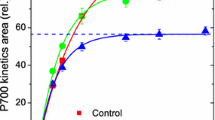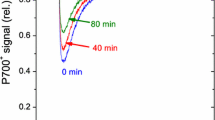Abstract
Using radioactively labelled amino acids to investigate repair of photoinactivated photosystem II (PS II) gives only a relative rate of repair, while using chlorophyll fluorescence parameters yields a repair rate coefficient for an undefined, variable location within the leaf tissue. Here, we report on a whole-tissue determination of the rate coefficient of photoinactivation k i , and that of repair k r in cotton leaf discs. The method assays functional PS II via a P700 kinetics area associated with PS I, as induced by a single-turnover, saturating flash superimposed on continuous background far-red light. The P700 kinetics area, directly proportional to the oxygen yield per single-turnover, saturating flash, was used to obtain both k i and k r . The value of k i , directly proportional to irradiance, was slightly higher when CO2 diffusion into the abaxial surface (richer in stomata) was blocked by contact with water. The value of k r , sizable in darkness, changed in the light depending on which surface was blocked by contact with water. When the abaxial surface was blocked, k r first peaked at moderate irradiance and then decreased at high irradiance. When the adaxial surface was blocked, k r first increased at low irradiance, then plateaued, before increasing markedly at high irradiance. At the highest irradiance, k r differed by an order of magnitude between the two orientations, attributable to different extents of oxidative stress affecting repair (Nishiyama et al., EMBO J 20: 5587–5594, 2001). The method is a whole-tissue, convenient determination of the rate coefficient of photoinactivation k i and that of repair k r .








Similar content being viewed by others
Abbreviations
- Chl:
-
Chlorophyll
- f :
-
Functional fraction of PS II
- F o , F m :
-
Minimum and maximum Chl fluorescence yield of a dark-adapted leaf, respectively
- F v = (F m –F o ):
-
Variable fluorescence
- k i , k r :
-
Rate coefficient of photoinactivation and repair, respectively
- P700:
-
Special Chl pair in the PSI reaction centre
- PI:
-
Photoinactivation
- PS:
-
Photosystem
- ROS:
-
Reactive oxygen species
References
Aro E-M, Kettunen R, Tyysjärvi E (1992) ATP and light regulated D1 protein modification and degradation. Role of D1* in photoinhibition. FEBS Lett 297:29–33
Aro E-M, McCaffery S, Anderson JM (1993a) Photoinhibition and D1 protein degradation in peas acclimated to different growth irradiance. Plant Physiol 103:835–843
Aro E-M, Virgin I, Andersson B (1993b) Photoinhibition of photosystem II. Inactivation, protein damage and turnover. Biochim Biophys Acta 1143:113–134
Bachmann KM, Ebbert V, Adams WW III, Verhoven AS, Logan BA, Demmig-Adams B (2004) Effects of lincomycin on PSII efficiency, non-photochemical quenching, D1 protein and xanthophylls cycle during photoinhibition and recovery. Func Plant Biol 31:803–813
Chow WS (2001) The photoinactivation of photosystem II in leaves: a personal perspective. J Photosci 8:43–53
Chow WS, Aro E-M (2005) Photoinactivation and mechanisms of recovery. In: Wydrzynski T, Satoh K (eds) Photosystem II: the light-driven water: plastoquinone oxidoreductase. Advances in photosynthesis and respiration, vol 22. Springer, Dordrecht, pp 627–648
Chow WS, Hope AB (2004) Electron fluxes through photosystem I in cucumber leaf discs probed by far-red light. Photosynth Res 81:77–89
Chow WS, Hope AB, Anderson JM (1989) Oxygen per flash from leaf disks quantifies photosystem II. Biochim Biophys Acta 973:105–108
Chow WS, Fan D-Y, Oguchi R, Jia H, Losciale P, Park Y-I, He J, Öquist G, Shen Y-G, Anderson JM (2012) Quantifying and monitoring functional photosystem II and the stoichiometry of the two photosystems in leaf segments: approaches and approximations. Photosynth Res 113:63–74
Ewart AJ (1896) On assimilatory inhibition in plants. J Linn Soc 31:364–461
Fish LE, Jagendorf AT (1982) High rates of protein synthesis by isolated chloroplasts. Plant Physiol 70:1107–1114
Greer DH, Berry JA, Björkman O (1986) Photoinhibition of photosynthesis in intact bean leaves: role of light and temperature, and requirement for chloroplast-protein synthesis during recovery. Planta 168:253–260
Grossman A, Bartlett S, Chua N-H (1980) Energy-dependent uptake of cytoplasmically synthesized polypeptide by chloroplasts. Nature 285:625–628
He J, Chow WS (2003) The rate coefficient of repair of photosystem II after photoinactivation. Physiol Plant 118:297–304
Hong S-S, Xu D-Q (1999) Light-induced increase in initial chlorophyll fluorescence F o level and the reversible inactivation of PS II reaction centers in soybean leaves. Photosynth Res 61:269–280
Hu Y-Y, Oguchi R, Yamori W, von Caemmerer S, Chow WS, Zhang W-F (2013) Cotton bracts are adapted to a micro-environment of concentrated CO2 produced by rapid fruit respiration. Ann Bot 112(1). doi:10.1093/aob/mct091
Kato MC, Hikosaka K, Hirotsu N, Makino A, Hirose T (2003) The excess light energy that is neither utilized in photosynthesis nor dissipated by photoprotective mechanisms determines the rate of photoinactivation in Photosystem II. Plant Cell Physiol 44:318–325
Klughammer C, Schreiber U (2008) Saturation Pulse method for assessment of energy conversion in PS I. http://www.walz.com/e_journal/pdfs/PAN07002.pdf. Accessed on 9 April 2013
Kou J, Oguchi R, Fan D-Y, Chow WS (2012) The time course of photoinactivation of photosystem II in leaves revisited. Photosynth Res 113:157–164
Kyle DJ, Ohad I, Arntzen CJ (1984) Membrane protein damage and repair: selective loss of a quinone-protein function in chloroplast membranes. Proc Acad Sci USA 81:4070–4074
Lee H-Y, Hong Y-N, Chow WS (2001) Photoinactivation of photosystem II complexes and photoprotection by non-functional neighbours in Capsicum annuum L. leaves. Planta 212:332–342
Losciale P, Oguchi R, Hendrickson L, Hope AB, Corelli-Grappadelli L, Chow WS (2008) A rapid, whole-tissue determination of the functional fraction of Photosystem II after photoinhibition of leaves based on flash-induced P700 redox kinetics. Physiol Plant 132:23–32
Losciale P, Chow WS, Corelli Grappadelli L (2010) Modulating the light environment with the peach ‘asymmetric orchard’: effects on gas exchange performance, photoprotection, and photoinhibition. J Exp Bot 61:1177–1192
Mattoo AK, Hoffman-Falk H, Marder JB, Edelman M (1984) Regulation of protein metabolism: coupling of photosynthetic electron transport to in vivo degradation of the rapidly metabolized 32-kilodalton protein of the chloroplast membranes. Proc Natl Acad Sci USA 81:1380–1384
Melis A (1999) Photosystem-II damage and repair cycle in chloroplasts: what modulates the rate of photodamage in vivo? Trends Plant Sci 4:130–135
Miyake C, Miyata M, Shinzaki Y, Tomizawa K-I (2005) CO2 response of cyclic electron flow around PSI (CEF-PSI) in tobacco leaves—relative electron fluxes through PS I and PS II determine the magnitude of non-photochemical quenching of Chl fluorescence. Plant Cell Physiol 46:629–637
Miyata K, Noguchi K, Terashima I (2012) Cost and benefit of the repair of photodamaged photosystem II in spinach leaves: roles of acclimation to growth light. Photosynth Res 113:165–180
Nishimyama Y, Yamamoto H, Allakhverdiev SI, Inaba M, Yokota A, Murata N (2001) Oxidative stress inhibits the repair of photodamage to the photosynthetic machinery. EMBO J 20:5587–5594
Nishimyama Y, Allakhverdiev SI, Murata N (2011) Protein synthesis is the primary target of reactive oxygen species in the photoinhibition of photosystem II. Physiol Plant 142:35–46
Oguchi R, Terashima I, Chow WS (2009) The involvement of dual mechanisms of photoinactivation of photosystem II in Capsicum annuum L. plants. Plant Cell Physiol 50:1815–1825
Oguchi R, Terashima I, Kou J, Chow WS (2011a) Operation of dual mechanisms that both lead to photoinactivation of photosystem II in leaves by visible light. Physiol Plant 142:47–55
Oguchi R, Douwstra P, Fujita T, Chow WS, Terashima I (2011b) Intra-leaf gradients of photoinhibition induced by different color lights: implications for the dual mechanisms of photoinhibition and for the application of conventional chlorophyll fluorometers. New Phytol 191:146–159
Ohad I, Kyle DJ, Arntzen CJ (1984) Membrane protein damage and repair: removal and replacement of inactivated 32-kDa polypeptides in chloroplast membranes. J Cell Biol 99:481–485
Ohad I, Kyle DJ, Hirschberg J (1985) Light-dependent degradation of the QB-protein in isolated pea thylakoids. EMBO J 4:1655–1659
Ohad I, Berg A, Berkowicz SM, Kaplan A, Keren N (2011) Photoinactivation of photosystem II: is there more than one way to skin a cat? Physiol Plant 142:79–86
Powles SB (1984) Photoinhibition of photosynthesis induced by visible light. Annu Rev Plant Physiol 35:15–44
Prásil O, Adir N, Ohad I (1992) Dynamics of photosystem II: mechanism of photoinhibition and recovery processes. In: Barber J (ed) Topics in photosynthesis, vol 11. Elsevier, Amsterdam, pp 295–348
Raven JA (2011) The cost of photoinhibition. Physiol Plant 142:87–104
Samuelsson G, Lönneborg A, Rosenquist E, Gustafsson P, Öquist G (1985) Photoinhibition and reactivation of photosynthesis in the cyanobacterium Anacystis nidulans. Plant Physiol 79:992–995
Sundby C, McCaffery S, Anderson JM (1993) Turnover of the photosystem II D1 protein in higher plants under photoinhibitory and nonphotoinhibitory irradiance. J Biol Chem 268:25476–25482
Taniguchi M, Kuroda H, Satoh K (1993) ATP-dependent protein synthesis in isolated pea chloroplasts. FEBS Lett 317:57–61
Terashima I, Fujita T, Inoue T, Chow WS, Oguchi R (2009) Green light drives leaf photosynthesis more efficiently than red light in strong white light: revisiting the enigmatic question of why leaves are green. Plant Cell Physiol 50:684–697
Tyystjärvi E (2008) Photoinhibition of photosystem II and photodamage of the oxygen evolving manganese cluster. Coord Chem Rev 252:361–376
Tyystjärvi E, Aro E-M (1996) The rate constant of photoinhibition, measured in lincomycin-treated leaves, is directly proportional to light intensity. Proc Natl Acad Sci USA 93:2213–2218
van Gorkom HJ, Schelvis JPM (1993) Kok’s oxygen clock: what makes it tick? The structure of P680 and consequences of its oxidizing power. Photosynth Res 38:297–301
Vass I (2011) Role of charge recombination processes in photodamage and photoprotection of the photosystem II complex. Physiol Plant 142:6–16
Wettern M (1986) Localization of 32000 dalton chloroplast protein pools in thylakoids: significance in atrazine binding. Plant Sci 43:173–177
Acknowledgments
The support of this work by an Australian Research Council Grant (DP1093827) awarded to W. S. C., the Joint Funds of the National Natural Science Foundation of China Grant (No. U1203283) and a National Key Technology R and D Program of China Grant (2007BAD44B07) to Z. W. F., and a Knowledge Innovation Program of the Chinese Academy of Sciences grant (KZCX2-XB3-09-02) to D. -Y. F. is gratefully acknowledged. W. S. C. values the friendship with Gov that started at a meeting in China in 1984. W. S. C. has long admired the work of Pierre J., as well as the life and work of Pierre’s grandparents.
Author information
Authors and Affiliations
Corresponding authors
Additional information
Yuan-Yuan Hu and Da-Yong Fan contributed equally to this study.
Rights and permissions
About this article
Cite this article
Hu, YY., Fan, DY., Losciale, P. et al. Whole-tissue determination of the rate coefficients of photoinactivation and repair of photosystem II in cotton leaf discs based on flash-induced P700 redox kinetics. Photosynth Res 117, 517–528 (2013). https://doi.org/10.1007/s11120-013-9822-5
Received:
Accepted:
Published:
Issue Date:
DOI: https://doi.org/10.1007/s11120-013-9822-5




